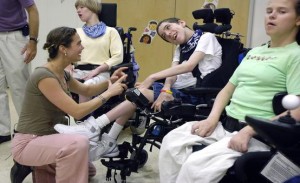Atonic Cerebral Palsy in Children

Atonic Cerebral palsy
Cerebral palsy is a general term for a collection of disorders. Read on to find out more about atonic cerebral palsy.
Cerebral palsy affects parts of the brain connected to muscle tone and movement. As a result, some people with this condition may have low muscle tone or severely contracted muscles, making it hard for them to move from one point to another without assistance.
Atonic cerebral palsy refers to about 9 forms of muscle movement difficulties caused by brain damage or brain structure malformation. This condition is so rare and subtle that it may be hard to get an accurate diagnosis unless you consult a highly qualified healthcare professional.
Lack of Head Control
People with atonic cerebral palsy may have little to no control of their head and neck. Their head may flop from one side to the other. This is usually first seen in childhood during developmental stages when a child is expected to start crawling. Due to lack of neck muscle tone, a child with atonic cerebral palsy may not even be able to lift their head off a surface, crawl, or walk well. Their arms and legs may also hang down like a rag doll.
Awkward Movements
Atonic cerebral palsy may also make someone’s movement seem awkward, and they may not have quick reflexes. Additionally, people with this type of cerebral palsy variation may have posture problems, as well as difficulties breathing, swallowing and speaking.
Causes Behind Atonic Cerebral Palsy
Atonic cerebral palsy is commonly thought to occur as a result of damage to the cerebellum. This is a part of the brain responsible for controlling balance and coordination. Lesions on this part of the brain may be due to an infection during the first 5 months of the baby’s development in its mother’s womb, but most-commonly tend to occur during a difficult delivery.
Any kind of infection that the mother incurs during pregnancy usually leads to the rise of cytokines, producing inflammation. This can then lead to fetal brain damage, causing atonic cerebral palsy before, during or shortly after birth.
If left untreated, atonic cerebral palsy may progress further and lead to complications such as
- Vision problems
- Delayed gastric emptying
- Muscular atrophy
- Acid reflux
- Impaired cardiac function
- Lack of bladder control
Atonic cerebral palsy can be managed in different ways. To begin with, it’s important for you as a parent to find a neurologist, developmental pediatrician, and/or movement disorder specialist in order to find out the extent of the condition. You can also document various challenges faced by the child and give this to the attending doctor so they can have an accurate picture of the disorder as it relates to your child.
Your doctor may recommend a range of treatment options, including physical therapy, strength training and other neuromuscular exercises to manage the disorder.
